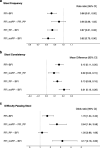Infant feeding practice and gastrointestinal tolerance: a real-world, multi-country, cross-sectional observational study
- PMID: 36514058
- PMCID: PMC9749164
- DOI: 10.1186/s12887-022-03763-8
Infant feeding practice and gastrointestinal tolerance: a real-world, multi-country, cross-sectional observational study
Abstract
Background: Signs of feeding intolerance, such as gastrointestinal (GI) symptoms, are frequently observed in otherwise healthy formula-fed infants in the first months of life. The primary objective of this observational study was to examine GI tolerance in formula-fed infants (FFI) vs. breastfed infants (BFI) in a real-world setting with a secondary objective being the comparison of infants fed formula with pre- and/or probiotics (FFI_PP) and those fed formula without any pre- and/or probiotics (FFI_noPP) as well as BFI.
Methods: A six-country, cross-sectional study in full-term exclusively/predominantly FFI (n = 2036) and BFI (n = 760) aged 6-16 weeks was conducted using the validated Infant Gastrointestinal Symptom Questionnaire (IGSQ) and a Feeding Practice and Gut Comfort Questionnaire.
Results: The IGSQ composite score in FFI was non-inferior compared to BFI (mean difference [95%CI]: 0.17 [-0.34, 0.67]; non-inferiority p-value < 0.0001) and scores for BFI and FFI were below the threshold of 23, indicating no GI discomfort. Adjusted mean IGSQ scores ± SE were similar in FFI_PP (22.1 ± 0.2) and BFI (22.3 ± 0.3) while FFI_noPP (23.4 ± 0.3) was significantly higher and above 23 indicating some GI discomfort (mean differences [95%CI] FFI_noPP minus FFI_PP and FFI_noPP minus BFI were 1.28 [0.57, 1.98] and 1.09 [0.38, 1.80], respectively; both p < 0.01). Hard stools and difficulty in passing stool were more common in FFI compared to BFI (p < 0.01) but were less common in FFI_PP compared to FFI_noPP (p < 0.01). FFI_PP showed significantly less crying than FFI_noPP and was similar to BFI. Significantly fewer physician-confirmed colic episodes (Rome IV criteria) were reported in FFI_PP compared with FFI_noPP or BFI.
Conclusions: In this real-world observational study, FFI had non-inferior overall GI tolerance compared to BFI. Within FFI, infants receiving formulas with pre- and/or probiotics had a better GI tolerance, improved stooling and less infantile colic compared to those receiving formula without any pre- and/or probiotics and were more similar to BFI.
Trial registration: NCT03703583, 12/10/2018 ( https://clinicaltrials.gov/ct2/show/NCT03703583 ).
Keywords: Crying time; Gastrointestinal tolerance; Infant formula; Infantile colic; Prebiotics; Probiotics; Stooling pattern.
© 2022. The Author(s).
Conflict of interest statement
LL, NS, CIC, DE and IJ are or were current employees of Société des Produits Nestlé S.A., Vevey, Switzerland. YV has participated as a clinical investigator, and/or advisory board member, and/or consultant, and/or speaker for Abbott Nutrition, Ausnutria, Biogaia, By Heart, CHR Hansen, Danone, ELSE Nutrition, Friesland Campina, Nestle Health Science, Nestle Nutrition Institute, Nutricia, Mead Johnson Nutrition, Pileje, United Pharmaceuticals (Novalac), Yakult, Wyeth.
Figures



References
-
- Liu W, Xiao LP, Li Y, Wang XQ, Xu CD. Epidemiology of mild gastrointestinal disorders among infants and young children in Shanghai area. Zhonghua Er Ke Za Zhi. 2009;47(12):917–921. - PubMed
Publication types
MeSH terms
Associated data
LinkOut - more resources
Full Text Sources
Medical
Miscellaneous

